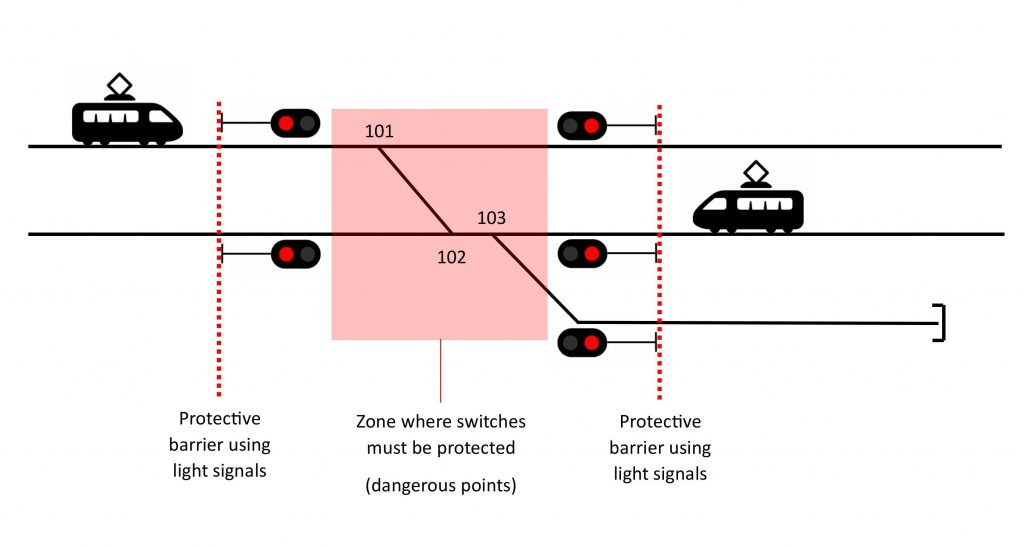Infrastructure • Railway signalling, today and tomorrow
Note: For educational purpose only. This page is meant purely as a documentation tool and has no legal effect. It is not a substitute for the official page of the operating company, manufacturer or official institutions. It cannot be used for staff training, which is the responsibility of approved institutions and companies.
Signalling yesterday and today
Signalling was a necessity from the very start of railway operations. As soon as several vehicles were able to travel at the same time on a network and on the same track, it was no longer possible to avoid an obstacle in the same way as on the roads, i.e. by sight. So we had to introduce something that roads don’t have:
• A detection system processing information known on the ground about whether or not the lane is occupied;
• A system of light signals and railway signs to which every driver must strictly obey
This signalling system comprises four sub-elements:

Train detection:
• General principles
• Detection equipment

Track components:
• Dead-end buffer
• Switches
• Crossing levels
• Movable bridges
• Shunting area

Light signals:
• Signal of yesterday
• Controlled signals
• Automatic block
• Railway signs
• ETCS signalling

Traffic conctrol:
• Itineraries
• Signalling boxes yesterday
• Signalling boxes today
Preliminary remark: this page is a dictionary and is intended for teaching purposes only. It can in no way be considered as an official course. The aim here is to provide explanations of the general principles of signalling, bearing in mind that this sector is intrinsically linked to national standards which are not repeated here.
General principles of rail signalling
The road mode is based on the principle of ‘seeing by sight’: you see the vehicles, the dangerous points, with your own eyes. You brake or start your vehicle according to your own visual assessment (and the load on your vehicle). This cannot be the case for a train.
Since a train is guided transport, it is screwed onto its rails and has no ability to avoid an obstacle. What’s more, its weight is such that in order to brake, it has to be warned well in advance, unlike a road vehicle, which can stop within a very short distance.
These factors led to the introduction of the principle of authorisation to travel via a range of light signals that train drivers will regularly encounter along their route and on entering – and leaving – stations or clusters.
Current railway signalling is therefore used in two main situations:
• To protect an area of dangerous points such as points, level crossings and others ;
• The protection of a section (or block) of 1500 or 2000m (or even more), in which only one train can run (block principle).
Protecting an area of dangerous points
The purpose of signals is to protect specific danger points on the rail network: level crossings, points and others. As shown in the diagram below, the principle is to create a barrier to protect an area. Here we see that an area with 3 points (in the red rectangle) must be protected and monitored, using a total of five signals. The basic principle is that trains can only be stopped in front of the signals, but never in the red rectangle. You can see this below with the positioning of the two trains, stopped in front of their respective signals.

When is a train allowed through the barrier? Simply when a traffic warden authorises it to do so. How does he do this? He locks the three points 101, 102 and 103 in the right direction, as shown below. Once a control system ensures that these switches are locked, safety is guaranteed, and the signal turns green. The train can then start and travel through the danger zone until it reaches the next signal, not visible on this diagram.

So there is no one manually setting a signal to green. This signal only turns green automatically if the three points 101, 102 and 103 have been checked as being properly locked. This is the interlocking principle, to which we’ll return in detail on another page.
As soon as the trains start and pass their signal, the signals automatically turn red because the downstream section is now occupied by each of the trains.

You have to wait until the train has completely cleared the switches area before you can free them and trace a new route for the waiting train (in green).

🟧
——————————————————————————————————————————————————————————————-
